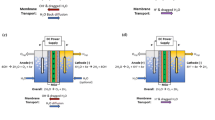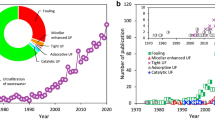Abstract
PANI particles were synthesised through the chemical polymerisation of an ammonium persulfate (APS) and aniline (ANI) solution with/without lithium chloride (LiCl) at different reaction times (6–24 h) and temperatures (3–24 °C). SEM images, along with GPC results, confirmed that PANI synthesised at different parameters affects the PANI morphology and molecular weight (MW). Meanwhile, TGA and DSC results represent the thermal properties of synthesised PANI and reveal that PANI without LiCl addition has the lowest melting temperature. Based on the results, the best PANI was successfully synthesised at a temperature of 3 °C and at a reaction time of 6 h with the addition of LiCl. A free-standing PANI membrane was obtained through phase inversion upon using PANI in NMP/4MP of 18, 20, and 23 wt%. A rejection study showed that the free-standing PANI membrane with 23 wt% concentration was in nanofiltration (NF), whereas others were in the ultrafiltration (UF) range.










Similar content being viewed by others
References
Idris A, Zain NM (2006) Effect of heat treatment on the performance and structural details of polyethersulfone ultrafiltration membranes. Jurnal Teknologi 44:27–40
Kim KJ, Fanen AG, Ben Aimb R, Liub MG, Jonsson G, TessaroC IC, Broekd AP, Bargemand D (1994) A comparative study of techniques used for porous membrane characterization: pore characterization. J Membr Sci 87:35–46
Patterson DA, Yenlau L, Roengpithya C, Gibbins E, Livingston A (2008) Membrane selectivity in the organic solvent nanofiltration of trialkylamine bases. Desalination 218:248–256
Ulbricht M (2006) Advanced functional polymer membranes. Polymer 47(7):2217–2262. doi:10.1016/j.polymer.2006.01.084
Khulbe KC, Feng CY, Matsuura T (2008) Synthetic polymeric membranes characterization. Atomic Force Microscopy 18:5–14
Ball IJ, Huang S-C, Wolf RA, Shimano JY, Kaner RB (2000) Pervaporation studies with polyaniline membranes and blends. J Membr Sci 174:161–176
Anderson MR, Mattes BR, Reiss H, Kaner RB (1991) Gas separation membranes: a novel application for conducting polymers. Synth Met 41:1151–1154
Macdiarmid AG, Chiang JC, Richter AF (1987) Polyaniline: a new concept in conducting polymers. Synth Met 18:285–290
Xu H, Li X, Wang G (2015) Polyaniline nanofibers with a high specific surface area and an improved pore structure for supercapacitors. J Power Sources 294:16–21
Harsha SK, Sumedh PS, Xinyu Z, Alan GM, Sanjeev KM (2005) Absolute molecular weight of polyaniline. J Am Chem Soc 127:6770–16771
Thanpitcha T, Sirivat A, Jamieson AM, Rujiravanit R (2008) Synthesis of polyaniline nanofibrils using an in situ seeding technique. Synth Met 158:695–703
Zujovic ZD, Bowmaker GA, Tran HD, Kaner RB (2009) Solid-state NMR of polyaniline nanofibers. Synth Met 159:710–714
Rahy A, Yang DJ (2008) Synthesis of highly conductive polyaniline nanofibers. Mater Lett 62:4311–4314
Wang Y, Chen K, Li T, Li H, Zeng R, Zhang R, Gu Y, Ding J, Liu H (2014) Soluble polyaniline nanofibers prepared via surfactant-free emulsion polymerization. Synth Met 198:293–299
Wang Y, Jing X (2007) Transparent conductive thin films based on polyaniline nanofibers. Mater Sci Eng B 138:95–100
Kerileng MM, Peter MN, Rachel FA, Gcineka M, Stephen MM, Njagi N, Milua M, Priscilla B, Emmanuel II (2012) Electronics of conjugated polymers (I): polyaniline. Int J Electrochem Sci 7:11859–11875
Nobrega MM, Izumi CMS, Temperini MLA (2015) Probing molecular ordering in the HCl-doped polyaniline with bulk and nanofiber morphology by their thermal behavior. Polym Degrad Stab 113:66–71
Jevremovic M, Zujovic Z, Stanisavljev D, Bowmaker G, Gizdavic-Nikolaidis M (2014) Investigation of the effect of acid dopant on the physical properties of polyaniline prepared using microwave irradiation. Curr Appl Phys 14:1201–1207
Yang D, Lu W, Goering R, Mattes BR (2009) Investigation of polyaniline processibility using GPC/UV–vis analysis. Synth Met 159:666–674
Monkman AP, Adams P (1991) Structural characterization of polyaniline free standing films. Synth Met 41–43:891–896
Adams PN, Laughlin PJ, Monkman AP (1994) A further step towards stable organic metals oriented films of polyaniline with high electrical conductivity and anistrophy. Solid State Commun 91:875–878
Mattoso LHC, MacDiarmid AG, Epstein AJ (1994) Controlled synthesis of high molecular weight polyaniline and poly(o-methoxyaniline). Synth Met 68:1–11
Wan M, Liu L, Wang J (1998) Electrical and mechanical properties of polyaniline films - Effect of neutral salts added during polymerization. Chin J Polym Sci 16:1–8
Adams PN, Monkman AP (1997) Characterization of high molecular weight polyaniline synthesized at −40 C using a 0.25:1 mole ratio of persulfate oxidant to aniline. Synth Met 87:165–169
Abdolahi A, Hamzah E, Ibrahim Z, Hashim S (2012) Synthesis of uniform polyaniline nanofibers through interfacial polymerization. Materials 5:1487–1494
Razali NF, Mohammad AW, Hilal N (2014) Effects of polyaniline nanoparticles in polyethersulfone ultrafiltration membranes: fouling behaviours by different types of foulant. J Ind Eng Chem 20:3134–3140
Huang X, McVerry BT, Marambio-Jones C, Wong MCY, Hoek EMV, Kaner RB (2015) Novel chlorine resistant low-fouling ultrafiltration membrane based on a hydrophilic polyaniline derivative. J Mater Chem A 3:8725–8733
Guillen GR, Farrell TP, Kaner RB, Hoek EMV (2010) Pore-structure, hydrophilicity, and particle filtration characteristics of polyaniline-polysulfone ultrafiltration membranes. J Mater Chem 20:4621–4628
Chapman P, Loh XX, Livingston AG, Li K, Oliveira TAC (2008) Polyaniline membranes for the dehydration of tetrahydrofuran by pervaporation. J Membr Sci 309:102–111
See-Toh YH, Silva M, Livingston A (2008) Controlling molecular weight cut-off curves for highly solvent stable organic solvent nanofiltration (OSN) membranes. J Membr Sci 324:220–232
Hoek EMV, Kaner RB, Guillen GR, Farrell TP (2014) Polyaniline membranes, uses, and methods thereto. California Patent WO2014059339 A1, 2013
Afzali A, Maghsoodlou S (2015) Acomprehensive review on computational methods. In: Klodzinska E (ed) Functional materials: properties, performance and evaluation, 1 edn. Apple Academic Press, Oakville, pp. 61–116
Sutherland KS, Chase G (2011) Filters and filtration handbook, 5 edn. Elsevier, Amsterdam
Lopez-Bonilla JL, Abdullin MI, Zaikov GE (2016) Physical chemistry for the chemical and biochemical sciences, 1 edn. CRC Press, Boca Raton
Anderson MR, Mattes BR, Reiss H, Kaner RB (1991) Conjugated polymer films for gas separations. Science 252:1412–1415
Kaner RB, Anderson MR, Mattes BR, Reiss H (1992) Membranes having selective permeability. California Patent WO1992003217 A1, 1991
Blinova NV, Stejskal J, Fréchet JMJ, Svec F (2012) Effect of reaction conditions on film morphology of polyaniline composite membranes for gas separation. J Polym Sci A Polym Chem 50:3077–3085
Sairam M, Loh XX, Li K, Bismarck A, Steinke JHG, Livingston AG (2009) Nanoporous asymmetric polyaniline films for filtration of organic solvents. J Membr Sci 330:166–174
Alam J, Dass LA, Alhoshan MS, Ghasemi M, Mohammad AW (2011) Development of polyaniline-modified polysulfone nanocomposite membrane. Appl Water Sci 2:37–46
Hopkins AR, Lipeles RA, Hwang S-J (2008) Morphology characterization of polyaniline nano- and microstructures. Synth Met 158:594–601
Huang J, Kaner RB (2004) A general chemical route to polyaniline nanofibers. J Am Chem Soc 126:851–855
Qiang J, Yu Z, Wu H, Yun D (2008) Polyaniline nanofibers synthesized by rapid mixing polymerization. Synth Met 158:544–547
Yılmaz F, Küçükyavuz Z (2009) The influence of polymerization temperature on structure and properties of polyaniline. E-Polymers 9:48–57
Tsutsumi H, Fukuzawa S, Ishikawa M, Morita M, Matsuda Y (1995) Preparation of polyaniline-poly(p-styrenesulfonic acid) composite by the post-polymerization method. Synth Met 72:231–235
Sengupta PP, Kar P, Adhikari B (2008) Effect of LiCl as an additive in the polymerization reaction of aniline and its influence on the structural and electrical property of polyaniline. React Funct Polym 68:1103–1112
Adams PN, Laughlin PJ, Monkman AP (1996) Low temperature synthesis of high molecular weight polyaniline. Polymer 37:3411–3417
Farrokhzad H, Darvishmanesh S, Genduso G, Van Gerven T, Van der Bruggen B (2015) Development of bivalent cation selective ion exchange membranes by varying molecular weight of polyaniline. Electrochim Acta 158:64–72
Cao Y, Andreatta A, Heeger AJ, Smith P (1989) Influence of chemical polymerization conditions on the properties of polyaniline. Polymer 30:2305–2311
Beadle PM, Nicolau YF, Banka E, Rannou P, Djurado D (1998) Controlled polymerization of aniline at sub-zero temperatures. Synth Met 95:29–45
Bláha M, Varga M, Prokeš J, Zhigunov A, Vohlídal J (2013) Effects of the polymerization temperature on the structure, morphology and conductivity of polyaniline prepared with ammonium peroxodisulfate. Eur Polym J 49:3904–3911
Sbaite P, Huerta-Vilca D, Barbero C, Miras MC, Motheo AJ (2004) Effect of electrolyte on the chemical polymerization of aniline. Eur Polym J 40:1445–1450
Sanches EA, Soares JC, Mafud AC, Fernandes EGR, Leite FL, Mascarenhas YP (2013) Structural characterization of chloride salt of conducting polyaniline obtained by XRD, SAXD, SAXS and SEM. J Mol Struct 1036:121–126
Mahato N, Parveen N, Cho MH (2015) Synthesis of highly crystalline polyaniline nanoparticles by simple chemical route. Mater Lett 161:372–374
Sanches EA, da Silva JMS, de O. Ferreira JM, JC S, dos Santos AL, Trovati G, Fernandes EGR, Mascarenhas YP (2014) Nanostructured Polyaniline Emeraldine-base form (EB-PANI): a structural investigation for different neutralization times. J Mol Struct 1074:732–737
Jing X, Wang Y, Wu D, Qiang J (2007) Sonochemical synthesis of polyaniline nanofibers. Ultrason Sonochem 14:75–80
Mara JRC, Martha FSL, Denise ML (2007) Polyaniline synthesized with functionalized sulfonic acids for blends manufacture. Mater Res 10:425–429
Luo K, Shi N, Sun C (2006) Thermal transition of electrochemically synthesized polyaniline. Polym Degrad Stab 91:2660–2664
Akbari A, Yegani R (2012) Study on the impact of polymer concentration and coagulation bath temperature on the porosity of polyethylene membranes fabricated via TIPS method. J Memb Separ Tech 1:100–107
Pesek SC, Koros WJ (1994) Aqueous quenched asymmetric polysulfone hollow fibers prepared by dry/wet phase separation. J Membr Sci 88:1–19
Acknowledgments
The authors would like to acknowledge the financial support of the Fundamental Research Grant Scheme (FRGS/2/2013/TK05/UKM/02/4), GGPM-074-2013(UKM), Department of Chemical and Process Engineering, Universiti Kebangsaan Malaysia and MyMaster by MOSTI for the MSc scholarship.
Author information
Authors and Affiliations
Corresponding author
Rights and permissions
About this article
Cite this article
Yusoff, I.I., Rohani, R. & Mohammad, A.W. Investigation of the formation characteristics of polyaniline and its application in forming free-standing pressure filtration membranes. J Polym Res 23, 177 (2016). https://doi.org/10.1007/s10965-016-1068-4
Received:
Accepted:
Published:
DOI: https://doi.org/10.1007/s10965-016-1068-4




